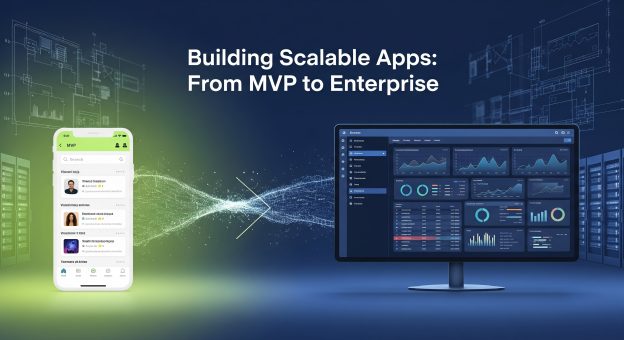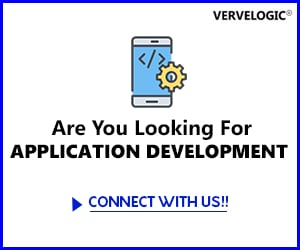Building Scalable Apps: From MVP to Enterprise

Start-ups and businesses often begin the development of a minimum viable product and launch it to gain traction from customers. By creating a minimum viable product, they can test and validate the ideas used in the mobile app or website. After gaining traction from customers on their minimum viable product, they are now in the position to scale the MVP into a full-fledged application.
In this blog, we will understand how entrepreneurs and start-ups develop their minimum viable product into a full-fledged, scalable enterprise application. What considerations should we keep in mind while scaling the MVP into an enterprise-level solution?
What is MVP? Why Invest in Minimum Viable Product?
The minimum viable product is not the end product. Entrepreneurs develop the application from the ground app, but create the solution in a way that feels complete in itself. Hence, the minimum viable product comes with all the necessary features and functions that customers will require. The MVP does not include very high-scale functionalities and characteristics because they may be highly resource and budget-intensive.
Hence, when the companies have limited funds and resources, developing a full-fledged application can be challenging as well as time-consuming. So, alternatively, start-ups and entrepreneurs begin by building the core features which are essential for an MVP. The core features are enough to solve the pain points and problems customers face.
Without adding any complex functionality or unnecessary features, entrepreneurs develop an MVP and release it quickly into the market. Now, let’s explore how companies should know when to scale their MVP into an enterprise-level application.
Why is a Minimum Viable Product Important for Companies
- Quick Testing and Validation: Start-ups and entrepreneurs develop a minimum viable product as they can test the product and validate the idea with real users. They have the time and space to accommodate changes and make transformations to the existing functionality. They can test the product in the market and take a survey from users to identify which features are highly liked by customers. The survey will also tell about the users who didn’t like the MVP features. Developers can eliminate such features from the app before making the MVP enterprise-level.
- Risk of Losing Resources is Eliminated: Developing a minimum viable product helps investors, start-ups and entrepreneurs in reducing the risk of losing resources in a product that might not be successful. What they say is true that you should not put all your eggs in one basket. Hence, before jumping right into the full-fledged application development, an MVP is a smart move by entrepreneurs and start-ups.
- Save Funds: The focus of the MVP is on the most critical features of the solution. Hence, companies can save their funds in creating a vast application which customers may reject later due to a number of reasons. Hence, by creating an MVP product, start-ups and entrepreneurs can test it in the market using several users. By keeping the feedback loop open, marketers and entrepreneurs can learn about the pain points and challenges faced by customers by using the MVP app.
How to Scale an MVP to Enterprise Level
Let’s understand how an MVP can be scaled into an enterprise-level mobile application-
#Step 1: Choose a Scalable Foundation
The first step is choosing scalable foundations on which the development will be done. Developers are not only building features for an MVP, but they are also developing the future architecture of the mobile app. Hence, start-ups and entrepreneurs require a scalable tech stack like react native, Flutter, Kotlin, Swift, etc.
#Step 2: Building Future-Ready Architecture
Future-ready architecture developers should plan for an API first architecture and a modular design. They should employ CI/CD pipelines from the beginning of the mobile application.
#Step 3: Plan for a Scalable Back-end Functionality
The back-end functionality of the mobile application should support the increasing user needs. The mobile application will be using more data, content and analytics as users grow. Hence, the backend of the mobile application must be robust. Start-ups can employ cloud architecture like GCP, Azure or AWS to provide an extendable database.
The mobile application will require a serverless or microservices architecture to scale the application horizontally. By employing a flexible database strategy like SQL for structure and NoSQL for speed, developers can create an enterprise-level application by scaling it from a minimum viable product.
#Step 4: Building Feedback Loop
The next step of building an enterprise-level application from an MVP is enabling a feedback loop in the app. Customers can provide their viewpoint and reviews using the feedback look in the application. Developers should track the performance of the application by using indicators such as churn points, user flows and load time.
To Sum Up
Creating a minimum viable product is only half a challenge in 2025. The true success comes from thinking of scalability from day one. It means that scalability can’t be added as an afterthought. The startups and entrepreneurs should design their MVP, which can be scaled into a full-fledged application when user demand increases. To build scalable and enterprise-level mobile applications, you can contact our developers at VerveLogic, a leading mobile application development company in USA. Our developers have worked on over 100+ scalable enterprise-level projects. They understand the user needs and fulfil customer demands by integrating scalable features into the mobile application.




